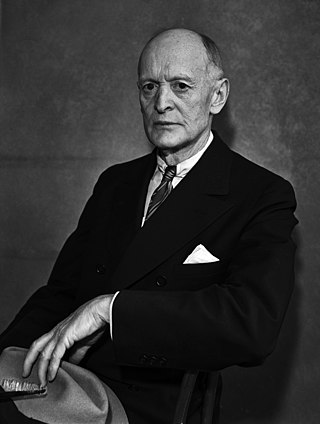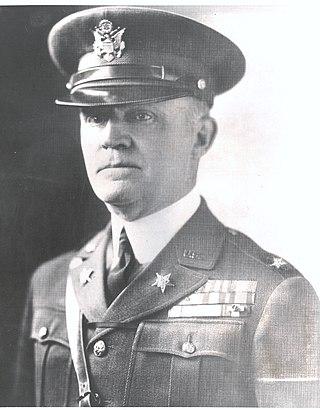
Lucius Roy Holbrook was a major general who commanded the United States Army's Philippine Department from 1936 to 1938.

The 79th Infantry Division was an infantry formation of the United States Army Reserve in World Wars I and II.

The 92nd Infantry Division was an African American, later mixed, infantry division of the United States Army that served in World War I, World War II, and the Korean War. The military was racially segregated during the World Wars. The division was organized in October 1917, after the U.S. entry into World War I, at Camp Funston, Kansas, with African American soldiers from all states. In 1918, before leaving for France, the American buffalo was selected as the divisional insignia due to the "Buffalo Soldiers" nickname, given to African American cavalrymen in the 19th century. The divisional nickname, "Buffalo Soldiers Division", was inherited from the 366th Infantry, one of the first units organized in the division.

Walter Scribner Schuyler was a career officer in the United States Army. A veteran of the American Indian Wars, Spanish–American War, Philippine–American War, and Mexican Border War, he attained the rank of brigadier general. A Cavalry officer, he carried out several high profile command assignments over the course of his military service, including the 5th Cavalry Regiment and Military District of Hawaii.

Herbert Jay Brees was a lieutenant general in the United States Army.

The role of Washington Territory in the American Civil War is atypical, as the territory was the most remote from the main battlefields of the conflict. The territory raised a small number of volunteers for the Union Army, who did not fight against the Confederate States Army but instead maintained defensive positions against possible foreign naval or land attacks. Although the Indian Wars in Washington were recent, there were no Indian hostilities within the area of modern Washington, unlike the rest of the western states and territories, during the Civil War. At the start of the American Civil War, modern-day Washington was part of the Washington Territory. On March 3, 1863, the Idaho Territory was formed from that territory, consisting of the entirety of modern-day Idaho, Montana, and all but southwest Wyoming, leaving the modern-day Washington as Washington Territory.

Isaac Rapp Brush was a decorated officer in United States Army with the rank of Major General. Brush commanded the 40th Infantry Division from 1942 to 1945 during its World War II involvement in the United States armed forces' liberation of the Philippines.

Ernest R. Redmond was a United States Army officer who served as acting Chief of the National Guard Bureau.

Major General Ira Thomas Wyche was a career officer in the United States Army who ultimately became Inspector General of the United States Army. A graduate of the United States Military Academy at West Point, during World War I he served in the American Expeditionary Forces (AEF) on the Western Front, and returned to the United States to train artillery students. He spent time teaching and attending various army schools from 1918 to 1942; including the United States Army Command and General Staff College and United States Army War College.

William Payne Jackson was a career officer in the United States Army. A veteran of the American Indian Wars, Spanish–American War, Philippine–American War, Moro Rebellion, Pancho Villa Expedition, and World War I he attained the rank of brigadier general during his career and major general on the army's retired list.

William Jones Nicholson was a career officer in the United States Army. He attained the rank of brigadier general during World War I as commander of the 157th Infantry Brigade, a unit of the 79th Division. He was most notable for leading his brigade to victory during the September 1918 Battle of Montfaucon, part of the first phase of the Meuse-Argonne Offensive, for which he received the Distinguished Service Cross.

Frederick B. Shaw was a senior officer of the United States Army. A veteran of the Spanish–American War, Philippine–American War, Pancho Villa Expedition, and World War I, he attained the rank of brigadier general and is best known for commanding the 162d Depot Brigade and 36th Infantry Brigade, 18th Division.

Alfred T. Smith was a career officer in the United States Army. A veteran of the Spanish–American War, Philippine–American War, and World War I, he attained the rank of brigadier general and was most notable for his command of the Philippine Division (1935–1937) and the 3rd Infantry Division (1937–1938).

William Renwick Smedberg Jr. was a career officer in the United States Army. A veteran of the Spanish–American War, Philippine–American War, and World War I, he attained the rank of brigadier general and was most notable for his command of the 305th Infantry Regiment, 153rd Infantry Brigade, 63rd Infantry Brigade, Military District of Arizona, 8th Cavalry Regiment, and 2nd Cavalry Brigade.

Charles F. Thompson was a career officer in the United States Army. A veteran of World War I and World War II, he attained the rank of major general and was notable as the first Chief of the United States Army Reserve and for his command of 3rd Infantry Division and I Corps.

Charles S. Kilburn was a career officer in the United States Army who attained the rank of brigadier general and was most notable for his World War II command of the 11th Armored Division from 1944 to 1945.

George Kennedy McGunnegle was a career officer in the United States Army. He received a direct commission from civilian life in 1873, and served until retiring 1919. McGunnegle attained the rank of colonel and was a veteran of the American Indian Wars, Spanish–American War, United States Military Government in Cuba, Philippine–American War, and World War I. He was most notable for his service in command assignments including the 1st Infantry Regiment and the Fort McDowell Recruit Depot in California.

Stephen O. Fuqua was a career officer in the United States Army. A veteran of the Spanish–American War, Philippine–American War, Pancho Villa Expedition, and World War I, he attained the rank of major general and was a recipient of the Army Distinguished Service Medal from the United States, and the French Legion of Honor (Chevalier), and Croix de Guerre.

John Fitz Madden was a career officer in the United States Army. A veteran of the U.S. response to the Garza Revolution, Spanish–American War, United States Military Government in Cuba, Philippine–American War, Pancho Villa Expedition, and World War I, he attained the rank of brigadier general and was a recipient of the French Legion of Honor (Officer) for his First World War service. Madden served in both high level staff positions, including chief quartermaster of the Pancho Villa Expedition, and important commands, including the 26th Infantry Regiment and the Hawaiian Division's 21st Infantry Brigade.

Daniel W. Hand was a career officer in the United States Army. A veteran of the Spanish–American War, Philippine–American War, Pancho Villa Expedition, and World War I, Hand attained the rank of brigadier general and was a recipient of the Army Distinguished Service Medal and Silver Star. He was best known for his command of Field Artillery units including the Department of Firing at the United States Army Field Artillery School and several Field Artillery regiments.






















